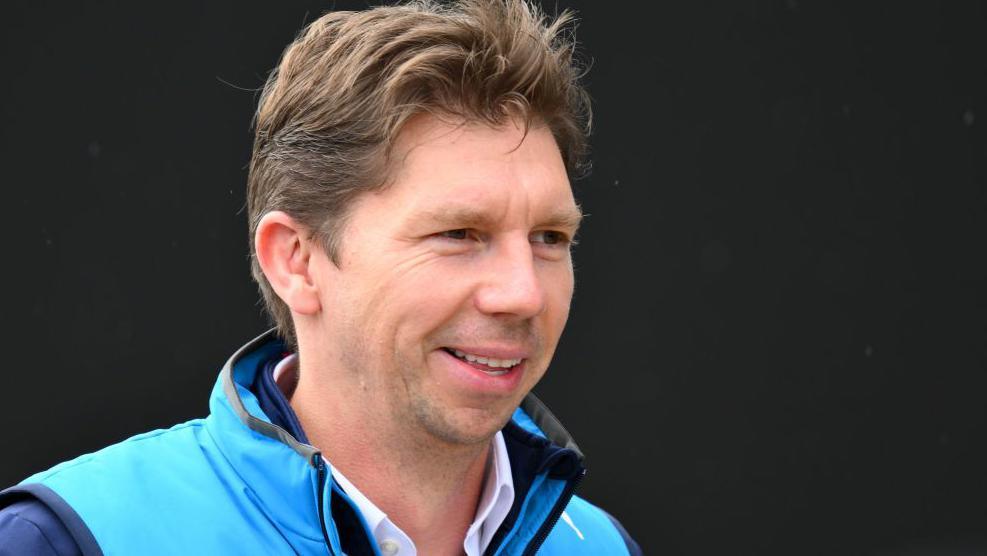Williams ‘not out of woods’, says team boss Vowles

James Vowles has been Williams team principal since February 2023
-
Published
Team principal James Vowles says Williams are “not out of the woods” despite an upturn in form in recent races.
Williams, who finished seventh in the constructors’ championship in 2023, had a difficult start to the season, scoring points only twice in the first 15 grands prix.
Their problems were a consequence of Vowles’ decision to “break so many systems” that had been in place at the team, to try to improve their performance after years of underachievement.
Since an upgrade was put on the car at the Dutch Grand Prix at the end of August, Williams drivers Alex Albon and Franco Colapinto have scored points three times in three races and quadrupled the team’s previous tally.
Vowles said: “Are we past the worst of it? Yes. Are we out of the woods? No.
“This isn’t success today. It’s just better than where we were before. Success is really being at the sharp end of the grid and we are nowhere near the end of that journey. We’re really starting it, I’m afraid.
“But I would also say that everything we have gone through has built a set of foundations that mean we won’t go back there again.”
Williams’ upturn in form has led to a seventh place for Albon in Azerbaijan and a ninth in Italy, and an eighth in Baku for Colapinto, who replaced Logan Sergeant when the American was sacked after the Dutch race for lack of pace and too many accidents.
At the start of the season the team were short of parts as a result of structural and operational changes at the factory that delayed the car-build process, and a series of accidents for Albon and Sargeant.
Vowles says: “A disaster would be a strong word but an adequate word for describing where we were. We weren’t scoring points. We moved backwards relative to our position in 2023.
“We did not do a good enough job. I knew there were risks involved. But we are here to develop our journey in the way we are not going to make baby steps any more. We are going to make large leaps and bounds and we are going to trip ourselves up on the way.”
The biggest issue slowing Williams early this year was that the car was overweight, as a result of compromise car-build decisions that had to be made over the winter because of the impact of the changes being imposed on the team.
“The main thing is that the set of decisions that led to us being in that awkward situation at the beginning of the year are the same set of decisions that led us to where we are today, which is making sure we’re challenging everything in the status quo, making sure we are developing the car at a scale we haven’t done previously,” Vowles said.
“So it would be surprising to say that where we are today is no different to where we were in the winter in terms of decision-making, it’s just the set of outcomes are different as well.
“The car is competitive. It has been all season long, it’s just the weight hid it. A lot of [the progress] is weight being taken out of the car. The second is, the way we are developing the car aerodynamically, I can’t tell you for a fact is different to other teams up and down the grid, but what I can say to you is when we add performance to the car, it is translating.”
Dropping Sargeant for Colapinto
Logan Sargeant was dropped by Williams following a crash in practice for the Dutch Grand Prix
A key influence in Williams’ recent turnaround is the decision to sack Sargeant and employ Colapinto, a member of the Williams driver development programme who previously had been having a decent but not outstanding season in Formula 2.
Vowles had considered replacing Sargeant after an unconvincing debut season in 2023, but gave him a second chance.
But after lagging behind Albon all year, a poor weekend in Zandvoort proved the final straw. Sargeant crashed the car in free practice having put a wheel on wet grass on the straight, writing off all its upgrades, and then was uncompetitive in a rebuilt car in the race.
Vowles said that Sargeant had been warned “multiple times” not to damage the car before his crash.
“First and foremost, I think rookies get a hard time in our sport,” Vowles said. “They’re very easily judged by individuals.
“My job in all this, as it is with every team member, is for me to have their back so they can perform at the absolute best they can. And I will be the last person pushing them down. I’ll make a decision when you absolutely categorically have to make a decision.
“Once we had delivered a car to what I consider is a good-enough standard in F1, now you look to make sure that we have other elements that we change. And that case in point was Logan.
“Logan was given an opportunity with all the updates, with the clear brief that went into it. Both drivers had that brief. But at the point where it was very abundantly clear to me that we are not going to hit our targets this year, that’s the point at which I’m OK to make a change.”
Vowles’ decision to promote 21-year-old Colapinto was questioned in some quarters, but he says he always believed the Argentine would vindicate it.
“There is a reason why we put him in the car,” Vowles said.
“It was based off tens of thousands of simulator kilometres. It was based off a decision actually made much earlier to put him in the car (in practice at) at Silverstone, and based on the fact he, the right word, is he shone.
“And his attitude. Speak to him in the car and he’s talking like you and I are talking now. There is zero pressure of the world on his shoulders.”
Vowles does say that Colapinto’s consistency has surprised him – he says he expected him to be close to Albon when he made his debut at Monza, but that he would “step back just a little bit” in Baku and Singapore before “flying across” the forthcoming events in the US, Mexico and Brazil.
He says the fact Colapinto was so competitive with Albon in Azerbaijan and Singapore was “impressive”.
William cannot give Colapinto a race seat next year because they have already signed Carlos Sainz from Ferrari to partner Albon.
Vowles is trying to get his protege a seat at Sauber, which is morphing into Audi in 2026, and said: “What I can say is should he not get a drive, he’ll be kept very close to us, run in our historic car, keep him up to speed. We’ll have the best reserve driver on the grid while we build him into a situation for the future.”
The ‘best line-up on the grid’?
Carlos Sainz, who is moving to Williams for 2025, is fifth in this year’s drivers’ championship
When Williams announced they had signed Sainz, Vowles said he believed he now had the best driver line-up on the grid.
The claim raised eyebrows, considering that next year Ferrari have seven-time champion Lewis Hamilton and Charles Leclerc, who has proved superior to Sainz in their four years as team-mates. A case could also be made for Lando Norris and Oscar Piastri at McLaren, while Red Bull have the sport’s acknowledged current number one in Max Verstappen.
How does Vowles justify that statement?
“I will put it into the context of, what do we need here?” Vowles said. “I need drivers, two of them, who will be decisive and strong within the team in order to find performance. Not within themselves; not fighting each other but actually moving the team whole.
“That means no politics. It means what you do in the car is what you do in the car but you work together as one unit. And I think you’ll find that same lack of politics doesn’t exist in a lot of the other teams you’ve just mentioned.
“So the best driver line-up, often individuals will go straight to performance or number of championships. But I think it’s a lot wider than that when you are in a team that needs internal leadership without in-fighting to move forward.”
He says he sees next season as a building year towards 2026, when new rules come in on both chassis and engines and which Williams hope will mark the beginning of their real quest to return to their glory days of the 1980s and 1990s.
“The owners are some of the most supportive I could ever ask for,” Vowles said of US finance company Dorilton. “They have not put a timeline on my shoulders of ‘you must fix it by then’. The clear objectives are forward progress and making sure we’re investing in the right areas. Those are the key targets.
“The top three teams, top four now, are of such a high standard that it would be naive to think you can spend the same money as them and be in the same position as them. Many of them have been in that position for many, many years.
“What I have said externally is: ‘Expect good results as we get towards ’28.’ That’s a sensible period of time in front of us. ’26 we’ll move forward, I have no doubt about it, but the real infrastructure starts kicking in in ’27, ’28.”
McLaren progress ‘inspirational’
That list of top teams now includes McLaren, who have performed a remarkable turnaround from having pretty much the slowest car at the start of last season to leading the constructors’ championship going into the climax of this year.
Has that made Vowles’ life more difficult?
He says: “It’s interesting that you’ve taken the time line of ’23 to ’24. Their real journey started about six years ago and what you’re seeing is the fruits of the labour that come six years later. Well done to them.
“They have done incredibly well. But it’s not the work of one year, it’s the work of many, many years building up. As it always is in sports where you have teams competing for milliseconds over each other.
“It is about the same timescale as I’m aiming to achieve things on. It’s about the same methodology that we’re going to go about doing things.
“You have a team, McLaren, that is leading the constructors’ championship, without necessarily some of the resources of some of the teams around it. That for me is a beacon on the hill that I look forward to joining.
“What it shows you is that even with infrastructure that is not necessarily at the level of some of the greats in the sport, you can achieve well. And for me it’s inspirational and that’s how I treat it.”
Listen to the full interview with James Vowles on 5 Live Formula 1 at 19:30 BST on Thursday, 17 October





